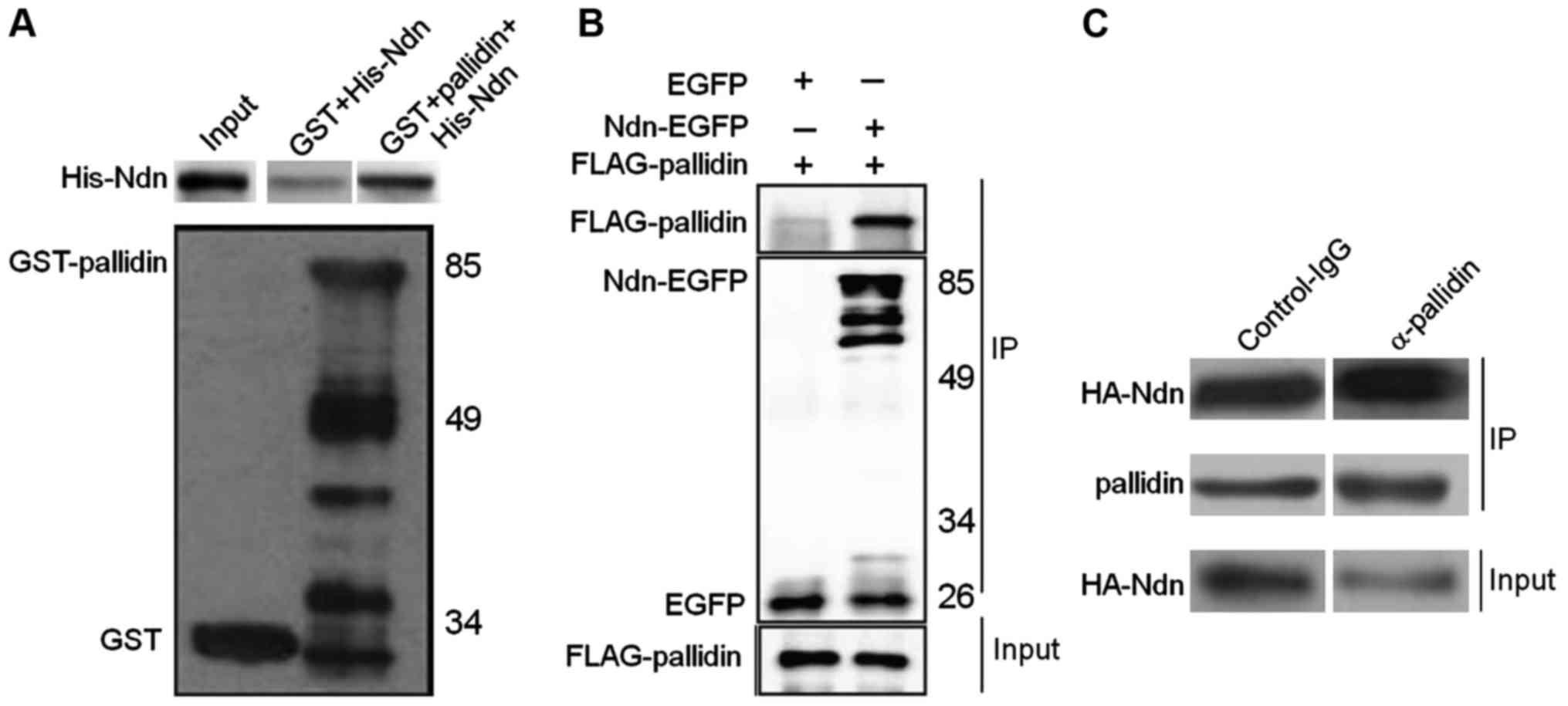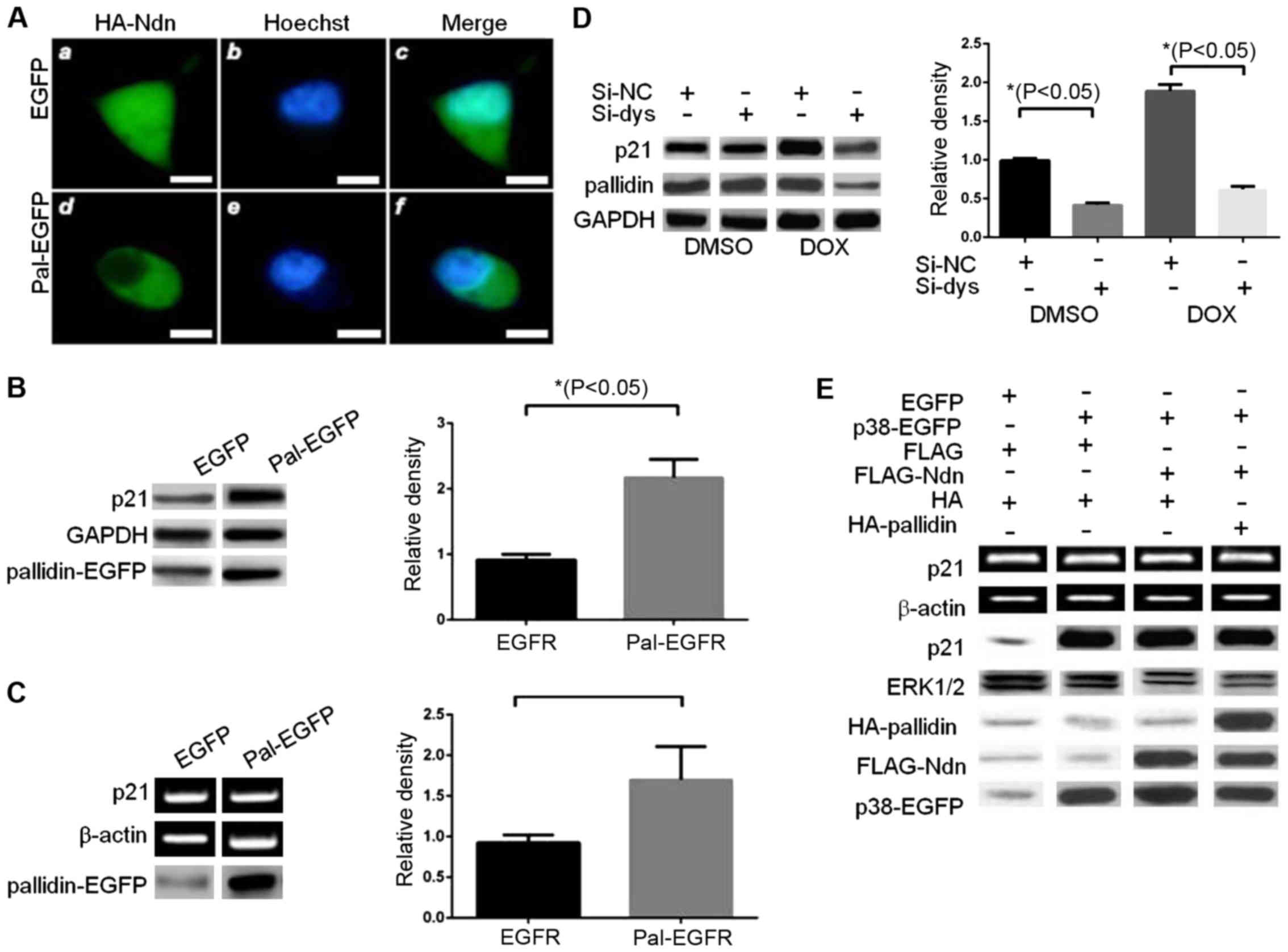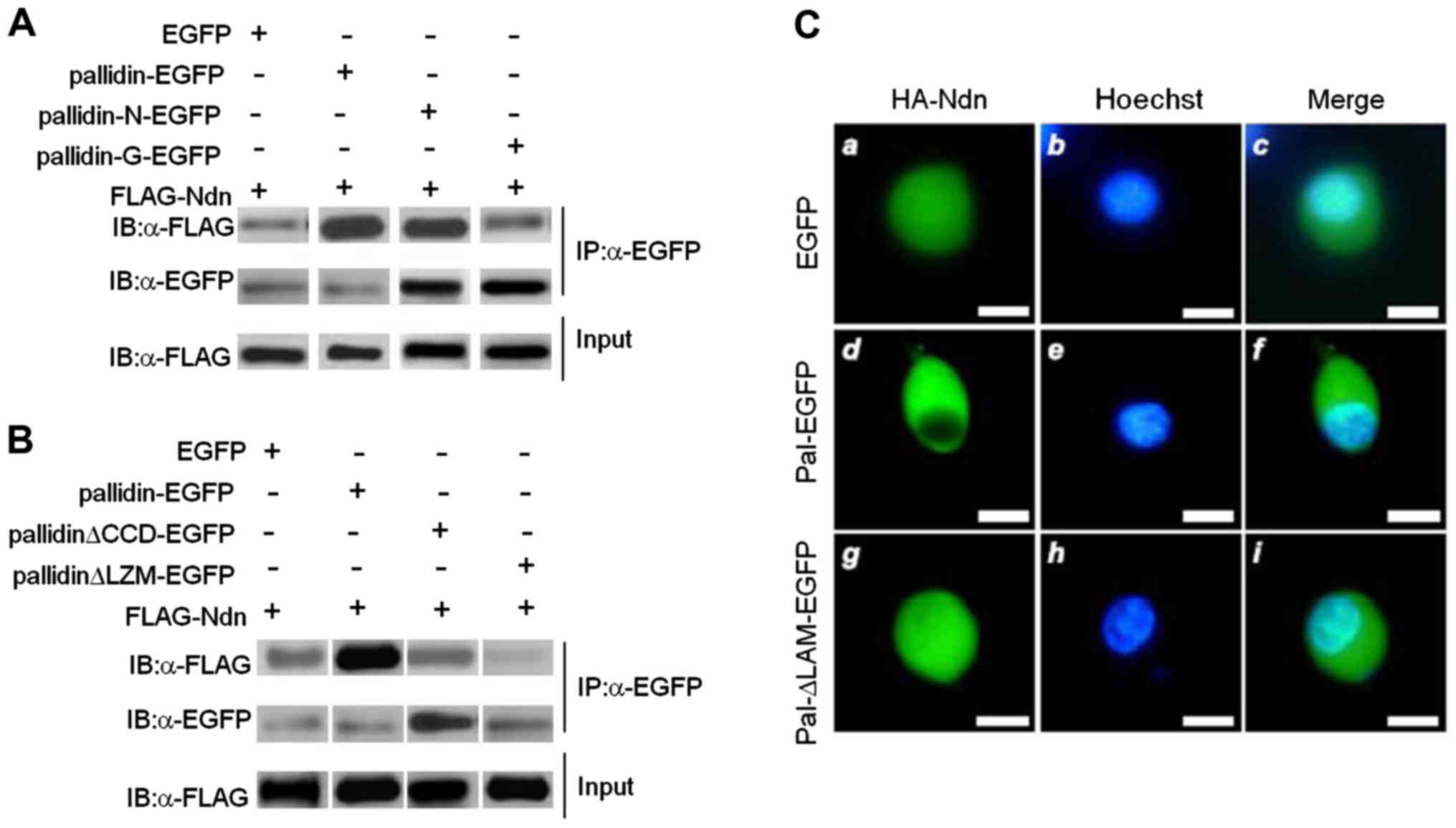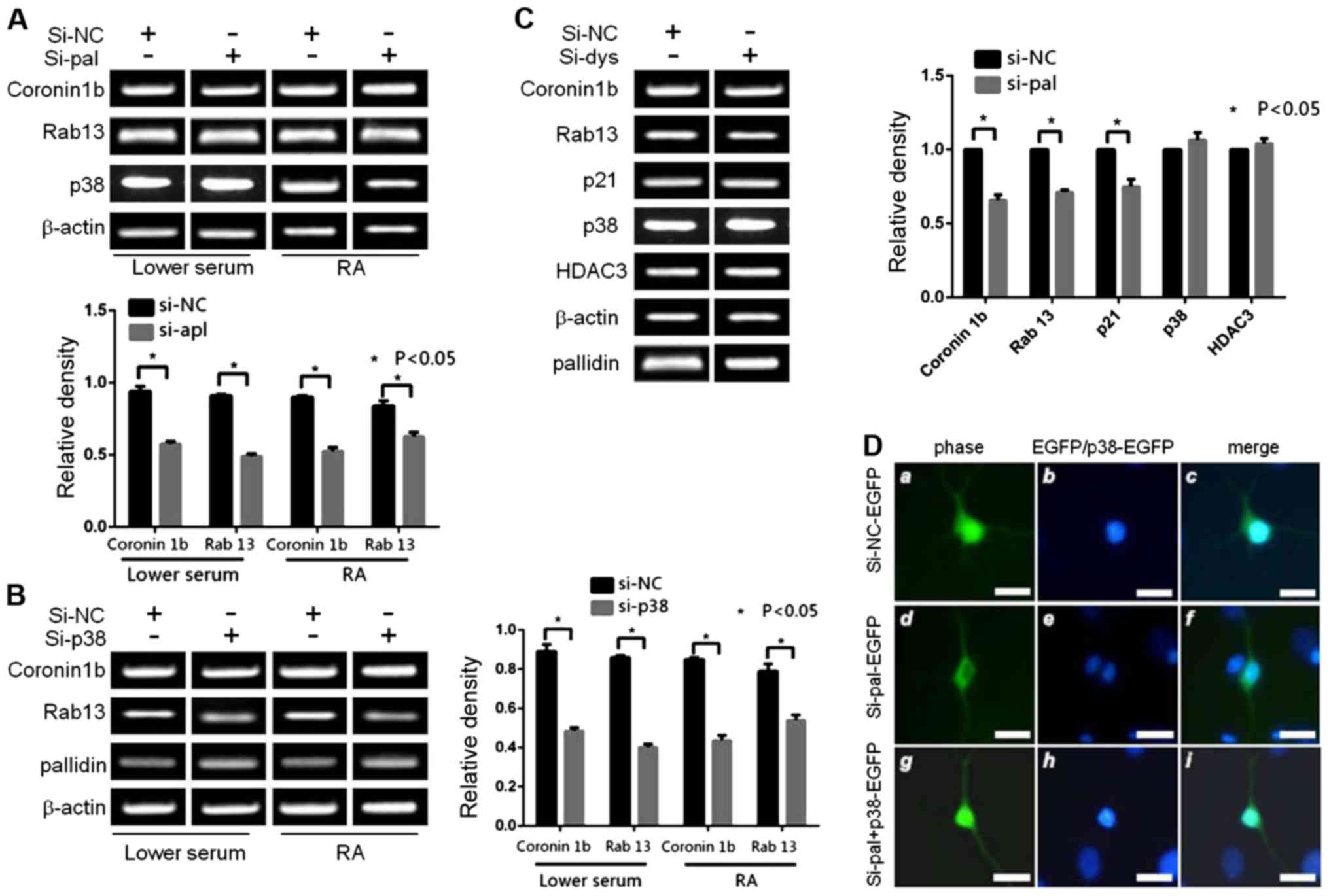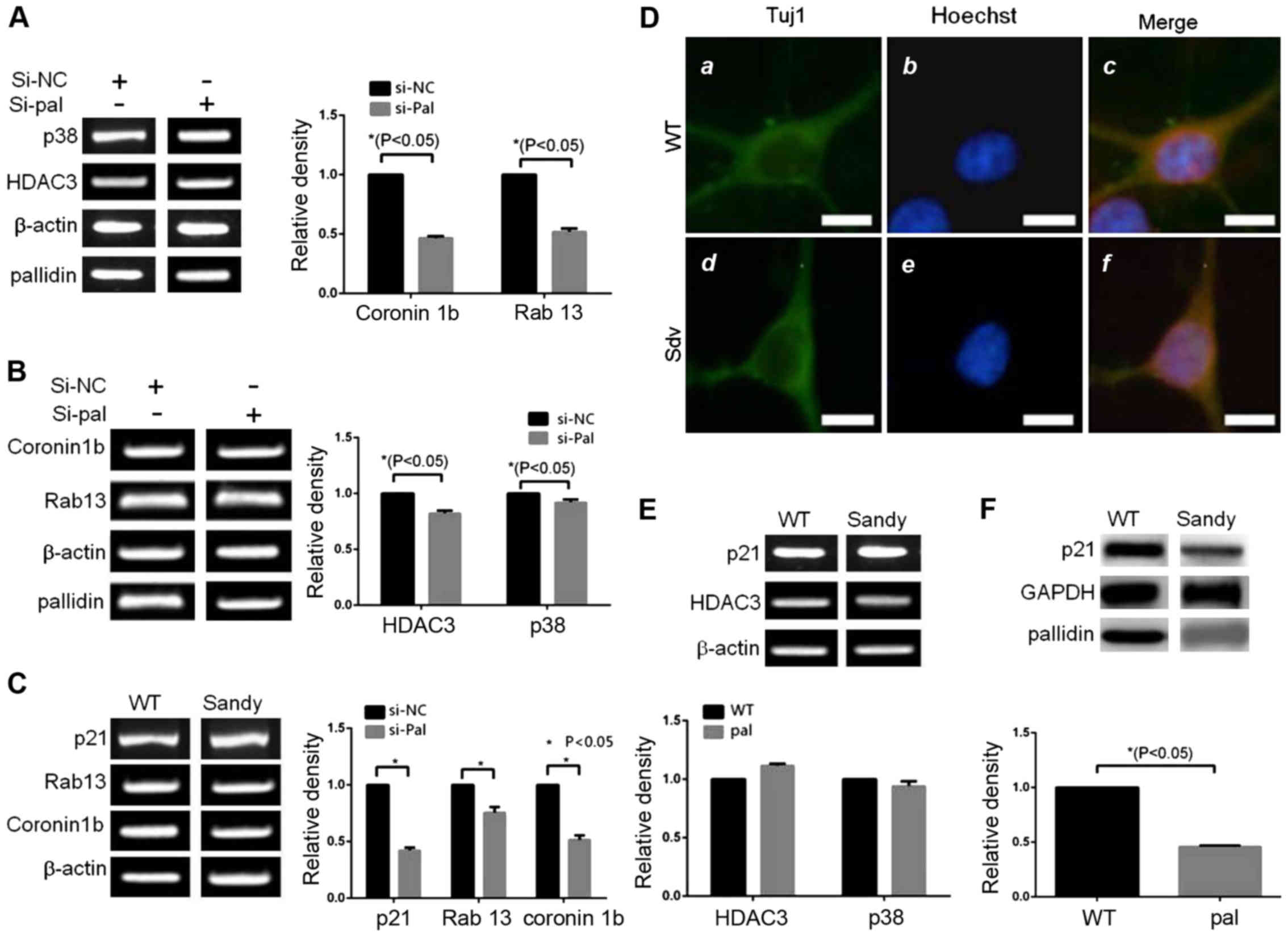Pallidin protein in neurodevelopment and its relation to the pathogenesis of schizophrenia
- Authors:
- Published online on: December 21, 2016 https://doi.org/10.3892/mmr.2016.6064
- Pages: 665-672
-
Copyright: © Shi et al. This is an open access article distributed under the terms of Creative Commons Attribution License.
Abstract
Introduction
Schizophrenia is a mental disease of unknown etiology. The patients are characterized by experiencing distortions of reality and disturbances of thought and language, and tend to withdraw from social contact (1). Neurotransmitter disturbances are considered an important factor leading to the development of schizophrenia (2). The fact that the functions of multiple known susceptibility genes seem to relate them to the neurotransmitter system provides molecular evidence for the validity of the neurotransmitter hypothesis.
In addition to the neurotransmitter system abnormality hypothesis, a large amount of research focuses on schizophrenia as a neurodevelopmental disease. Since the early 1980s, researchers have been documenting structural abnormalities on the brains of schizophrenia patients shown on CAT images, and it has been found that the weight of brains of patients is lighter on average than those of non-affected individuals. Specialists attribute this specific finding to abnormalities occurring during early development (3).
With the progress in imaging science, studies now further show that the abnormal cerebral development of schizophrenic patients results in a decrease in volume of the lateral cerebral ventricle, of the grey and white matter, and of some special functional areas such as the hippocampus, and the prefrontal cortex. Based on imaging findings and postmortem examinations of brains, the number of neuron dendritic spines is decreased significantly in schizophrenic patients compared to non-affected individuals (4).
Pallidin is a protein widely expressed in various mammalian tissues. The earliest research showed it to be highly expressed in the brain and skeletal muscle (5). However, further studies have confirmed it is also widely expressed in the central nervous system (CNS) (6). Immunohistochemistry shows pallidin is highly expressed in the glutamatergic neurons of the hippocampus, including some large cone neurons in the neocortex, stellate cells in the entorhinal cortex, and large neurons in the cerebellar nuclei (7). The ACh neurons in the basal forebrain and cranial motor nuclear cluster, the dopaminergic neurons and GABA neurons in the substantia nigra, and the tryptamine neurons in the brainstem also exhibit a certain expression level of the pallidin protein. This widespread presence suggests its participation in diverse neural networks (8). The studies focusing on the cellular localization of pallidin have aided researchers trying to elucidate the functions of this protein. Pallidin is a cytoplasmic protein, and immunoelectron microscopy results, in the granule cell layers of the mouse hippocampal area, have shown the presence of pallidin on neural presynaptic and postsynaptic membranes, indicating that the protein may participate in the regulation of synaptic activity. Furthermore, cell biology research has found pallidin in the cell nucleus, indicating that it may also exert nuclear functions (9).
p38 is a protein with important roles in cell apoptosis (10). However, a study shows that it also plays other roles in cells, including as an important transcription factor in the cell nucleus (11). p38 promotes the expression of multiple genes and regulates various functions of the cells after binding to a specific sequence on the genome. In recent years, a large amount of research points to the role of p38 in neuronal development, for instance as a result of its role in apoptosis, an essential factor in neuronal development (12). Furthermore, studies on the PCI2 cell line have shown that the transcriptional activity of p38 has a significant effect on the NGF-induced cell differentiation (13). PCI2 cells expressing exogenous p38 produce much shorter neurites than those that are produced in cells expressing p38 under control by the NGF, highlighting the importance of the interaction between these factors. Finally, two effector molecules related to neurite growth, namely small GTP enzyme Rab13 and F-actin binding protein coronin 1b, have also been found to be transcribed and are regulated by p38 during regenerating neurons (14).
The existing research shows that different enzymes can post-translationally modify newly synthesized p38 protein. Such modifications determine the downstream functionality of the resulting protein. This probably explains the dual functions attributed to p38 as an apoptosis-promoting and a development-promoting mediator. Our experiments are based on the hypothesis that both pallidin and p38 are somehow related to the pathogenesis of schizophrenia at a neurodevelopmental level.
Materials and methods
Cell lines and experimental animals
All of the mammalian cell lines used (HEK293A, HCT116 and N2a) were purchased from the American Type Culture Collection (ATCC, Manassas, VA, USA). For culture, cells were immersed into MEM + 10% fetal bovine serum (FBS) + 1X antibiotic culture medium, and placed in an incubator containing 5% CO2 at 37°C. The Sandy mice (sdy/sdy) and wild mice (WT; +/+) were purchased from the Jackson Laboratory (Sacramento, CA, USA). All animal experiments were completed under the supervision of the Animal Ethics Committee of Bingzhou People's Hospital (Shandong, China). The mice were sacrificed by decollation after the experiment and cerebral tissues were extracted for later use.
Separation and culture of primary neurons
Mouse cortical neurons were separated from the cortical tissue of neonatal mice aged 0–1 days. The cortical tissue was separated into fragments with tweezers in a 1X phosphate-buffered saline (PBS) glass dish. The tissues were incubated with 0.5% trypsin (Gibco-BRL Life Technologies Inc., Grand Island, NY, USA) for 20 min at 37°C, in an EP tube. The dislodged cells were gently centrifuged at 3,900 × g, seeded in a 24-well microplate, and cultured with Dulbecco's modified Eagle's medium (DMEM) + 10% FBS (Gibco-BRL Life Technologies Inc.) containing glutamine (3 pg/ml). After 24 h, the solution was changed to 1X NB/B27 containing glutamine (3 pg/ml) (15).
Polymerase chain reaction (PCR)
Mouse cerebral tissue (1 cm3) or 106 of the mammalian cells HEK293A, HCT116 and N2a were harvested. RNA was extracted using the TRIzol method and transcribed into cDNA. Each 20 µl PCR reaction solution including DNA polymerase (1 µl), reverse transcriptase (0.35 µl), and template RNA (5 µl) was well mixed and centrifuged at 3,900 × g for 10 sec. The amplification protocol program included a reverse transcription step for 25 min at 50°C; a pre-denaturation step for 3 min at 95°C; and 5 cycles of denaturation at 95°C for 15 sec, annealing for 30 sec at 50°C, and extension for 30 min at 72°C; and finally 40 cycles of a denaturation step for 10 sec at 95°C, and an annealing step for 40 sec at 55°C. The primers used in the experiment are listed in Table I.
Agarose gel electrophoresis
Once the agarose gel solution cooled to about 65°C it was mixed well, carefully poured into a glass plate, and allowed to stand at room temperature until gel coagulation. The gel and the glass plate were placed in the electrophoresis tank. A 1X TAE electrophoretic buffer solution was added until the gel plate was completely immersed. The DNA sample and loading buffer were mixed. The gel plate was energized for electrophoresis at a voltage of 60–100 V immediately after loading. The electrophoresis was terminated when the bromophenol blue reached a point ~1 cm from the lower edge of the gel plate. The gels were stained for about 20 min with ethidium bromide and rinsed for 10 min with clear water. Observations were performed under an ultraviolet lamp (Gemini Bio-Products, Woodland, CA, USA).
GST pull-down
The crude extract of the supernatant of the GST and GST-Tag fusion proteins (Invitrogen, Carlsbad, CA, USA) were bound to G4B. A crude extract of the supernatant of the second protein bound to the GST-Tag fusion protein was added. The samples were placed on a shaker platform for 1 h at 4°C, and then centrifuged for 5 min at 500 × g at 4°C. The supernatants were discarded. A 2X SDS gel loading buffer of appropriate amount was added to each sample. They were boiled for 5 min at 100°C, subjected to sodium dodecyl sulphate-polyacrylamide gel (SDS-PAGE), and Coomassie Brilliant Blue stained, or detected by western blot analysis (16).
Cell transfection (lipofection method)
Six-well microplates were inoculated with 1×105-3×105 cells (HEK293A, HCT116 and N2a) per well. For transfection, the cells were cultured in the incubator overnight until the cell density reached 50–80% confluence. The transfection procedure was done following the manufacturer's instructions. Briefly, 1–4 µg plasmid DNA (Sangon Biotech Co., Ltd., Shanghai, China) was used for transfections. DMEM was used to prepare solutions containing plasmid DNA-liposome compounds. The cells were washed with DMEM prior to the transfections. Next, 200 µl of the DNA-liposome compound solution were mixed with 0.8 ml DMEM and added to the cell incubation wells. The cells were placed back in the incubator for 4–6 h. Finally, 1 ml of the culture solution at a serum concentration equivalent to 2 times the normal was added to the cells in each well. Transfections were allowed to proceed for 18–24 h prior to changing the growth media.
Co-immunoprecipitation
Collected lysis buffers of supernatants containing lysed cell proteins were added to appropriate protein A or G gel columns (Bio-Rad Laboratories, Inc., Hercules, CA, USA) coupled with antibody. The protein extracts were incubated with the gel while shaking the mixture for over 5 h at 4°C.
The columns were then centrifuged for 3–5 sec at the highest speed at 4°C. The supernatant was carefully pipetted and discarded. Washing buffer (1 µl) was added to the columns. The washing proceeded for 20 min at 4°C. The washing steps were repeated once. The columns were centrifuged for 3–5 sec at the highest speed at 4°C. The supernatants were carefully pipetted out and discarded. Finally, a 2X SDS gel loading buffer solution of appropriate amount was added to the samples. The samples were boiled for 5 min at 100°C and then subjected to the SDS-PAGE analysis.
Western blot analysis
The pre-extracted mammalian cell proteins were subject to SDS-PAGE. Next, the gels were placed in a sandwich with transfer membrane in the electrical transfer tank (120 V 320 mA). The transfer proceeded for 60–90 min. The membranes were placed in a dish containing 25 ml blocking buffer. After 2 h on a shaker platform at room temperature, the primary antibodies were added: Anti-pallidin, HDAC3, his-Ndn, F-actin, GAPDH, and p21 (Jackson ImmunoResearch Laboratories, Inc., West Grove, PA, USA). The reactions were left incubating overnight at 4°C. The next day, each membrane was washed 3 times for 5 min with TBST on a shaker at room temperature. Appropriate secondary antibodies (Boster Inc., Wuhan, China) were added. Incubations took place on a shaker for 1 h at 37°C. The membrane was washed 3 times × 5 min with TBST. A developer was used to observe the results on a platform.
Immunocytochemistry
The mammalian cells (HEK293A, HCT116 and N2a) were washed 3 times × 5 min with PBS after growing on glass slides. A goat serum working solution was added carefully with a dropper. The slides were blocked for 20 min at 37°C. The goat anti-pallidin (1:500; cat. no. PA5-18160): rabbit polyclonal anti-HA-Ndn (1:500; cat. no. MA1-012X), mouse polyclonal anti-EGFP (1:500; cat. no. MA1953), and rabbit polyclonal anti-pal-EGFP (1:2,000; cat. no. PA527854) were added. The cells were allowed to stand overnight at 4°C, and then were washed 3 times for 5 min with PBS the next day. The specific secondary antibody polyclonal FITC (1:1,000; cat. no. A-11090; Invitrogen Life Technologies) was added. The reactions were incubated for 2 h at 37°C, stained with Hoechst for 5 min and washed with PBS 3 times for 5 min each. The sections were placed on clean glass slides, air dried, mounted with the anti-fluorescent quenching mounting solution, and conserved away from light at 4°C for microscopic examination.
RNA interference
The small RNA interference primers (Google Biotechnology Co., Ltd., Shanghai, China) were designed as follows: 5′-AAGUGACAAGUCAAGAGAAGCAA-3′ (target to human pallidin mRNA); 5′-AAGUGAUAAGUCAAGAGAAGCAA-3′ (target to mouse pallidin mRNA); 5′-AAGCGACAAGUCAAAAGAAGCAA-3′ (target to rat pallidin mRNA); and 5′-CCACUUGAUGGAGAGUAUU-3′ (target to mouse p38 mRNA). The cell densities were allowed to reach 40–60% confluence before transfection. The following solutions were prepared: Solution A with 2–10 µl Lipofectamine Oligofectamine (Invitrogen) transfection reagent and 80 µl Opti-MEM, which was incubated for 5 min at room temperature; and solution B with 4–8 µl of siRNA and 80 µl Opti-MEM. Solution A and B were mixed well together. The mixtures were allowed to stand for 30 min at room temperature. The cells were washed with Opti-MEM. Then 0.8 µl 0pti-MEM were added to each liposome mixture and the transfection mixture was added to the cells. The cultures were incubated for 4–6 h. Then the culture medium was replaced with a fresh one at 18–24 h after transfection. The cells were harvested 4–72 h after transfection.
Cell differentiation experiment and detection of the process of growth
N2a was cultured in complete medium (10% FBS + DMEM) for 24 h. The plasmid or siRNA (as above) was transfected with Lipofectamine 2000 or Oligo Lipofectamine for 6 h. Next, cells were cultured with DMEM containing 2% FBS to induce cell differentiation. The new processes on the cell membranes were observed under a microscope. Approximately 200–250 cells were counted in each experiment. The primary cortical neurons, separated from the neonatal mice, were inoculated into a 24-well microplate. The solution was replaced at 24 h. The cells were stained with Tuj (Biosynthan GmbH, Berlin, Germany) to show the neuronal processes 5 days after being cultured with NB/B27.
Detection of living cells with the MTT method
The plasmid at a determined concentration was used for transfections at a cell confluence of 50–60%. The original culture medium was pipetted out after 36–48 h. Cells were washed 2 times with 1X PBS. Five hundred microliters of MTT diluted with phenol red-free MEM was added to obtain a final concentration of 0.5 mg/ml. The reactions proceeded for 2–3 h at 37°C. Then, the excess MTT was absorbed, and 500 µl of 0.04 M acidulated isopropanol was added. The cell culture dish was gently shaken back and forth until the bluish violet crystal formazan was completely dissolved in the acidulated isopropanol. The supernatant was transferred to a 96-well ELISA plate (Thermo Fisher Scientific, Inc., Beijing, China). The optical density was determined at 570 nm (Thermo Fisher Scientific, Waltham, MA, USA).
Statistical analysis
The measurement data were expressed with mean ± standard deviation. The significance of the average differences between two groups of the data were tested with the t-test of two independent samples. The measurement data were expressed as a percentage. The Chi-square test was used for comparisons among groups. The differences were considered statistically significant when P<0.05. The SPSS 16.0 software was used to process the statistical data.
Results
Identification of binding between HDAC3 and pallidin
The experimental results showed that GST-pallidin co-immunoprecipitates with His-Ndn in vitro, whereas, not with the control GST alone. To further verify the binding between pallidin and HDAC3 in the mammalian cell lines, FLAG-pallidin and EGFP or Ndn-EGFP proteins were co-expressed in a human embryonic renal cell line (HEK293A). Subsequently, a co-immunoprecipitation experiment was conducted. The results indicated that FLAG-pallidin also co-precipitates with Ndn-EGFP when Ndn-EGFP was bound to the GFP antibody; as a negative control, EGFP alone was not able to co-precipitate FLAG-pallidin (Fig. 1B). Next, a dysbindin antibody (which can also bind pallidin) was used to precipitate the endogenous pallidin in a mouse neuroma mother cell line (N2a) transfected with HA-Ndn. The results showed that HA-Ndn and the endogenous pallidin co-precipitated, whereas the control IgG antibody was not able to precipitate as much HA-Ndn (Fig. 1C).
Pallidin changes localization and influences the transcriptional activity of p38
Immunofluorescence results indicated that overexpression of pallidin-EGFP caused a change in the cellular distribution of HA-Ndn, from being present normally in both the cytoplasm and nucleus to being present only in the cytoplasm (Fig. 2A). During previous experiments we observed that when exogenous p38 was overexpressed, the activity of the reporter gene was markedly increased. By contrast, the transcriptional activity of p38 was significantly inhibited by HDAC3 in the cells co-transfected with HDAC3 and p38. The transcriptional activity of endogenous HDAC3 increased significantly when pallidin was overexpressed (data not shown). Overexpression of pallidin-EGFP in the HCT116 p38 wild-type cell line increased the endogenous p21 protein and mRNA levels (Fig. 2B and C). The small RNA interference method was used to decrease the expression level of endogenous pallidin and observe the effects on the expression level of endogenous p21 in the HCT116 p38+/+ cell line. A decrease in p21 was still significant even after the p38 activator doxorubicin (DOX) was used to promote the transcriptional activity of endogenous p38 (Fig. 2D). Various different plasmids were transfected into HCT116 p38−/− cells as shown in Fig. 2E. It also indicated that pallidin was able to reverse the decrease of the p21 protein and RNA levels as a result of inhibitory effect of HDAC3. This coincided with the previous result of the reporter gene. In conclusion, pallidin was able to influence the transcriptional activity of the downstream p38 by changing the intracellular localization of HDAC3.
The 90–110 amino acid sequences of pallidin are participating in HDAC3 regulation
In co-immunoprecipitation experiments both pallidin-EGFP and pallidin-N-EGFP co-precipitated FLAG-HDAC3. However, neither pallidin-C-EGFP nor the negative control EGFP, were able to co-precipitate FLAG-HDAC3 (Fig. 3A). We established two pallidin mutants with either the CCD or LZM domains deleted. Co-immunoprecipitation assays were conducted after the two mutants and the full-length pallidin were co-transfected with FLAG-HDAC3. The result showed that both mutants lost their capacity to bind to HDAC3 (Fig. 3B). The full-length pallidin-EGFP enabled HA-HDAC3 to exhibit significant cytoplasmic localization. On the contrary, the pallidin-ALZM-EGFP without its leucine zipper was not able to influence the subcellular localization of HA-HDAC3. HA-HDAC3 exhibited uniform distribution in the cytoplasm and nucleus in the cells co-transfected with the mutant (similar to those transfected with EGFP control) (Fig. 3C).
Pallidin influenced growth of the differentiated cellular processes by regulating the downstream gene product of p38
The levels of mRNA in the p38 downstream target genes was detected with RT-PCR after the expression level of endogenous p38 was knocked down. At the same time, a western blot analysis demonstrated that the expression levels of the two effect proteins coronin 1b and Rab13 decreased (Fig. 4A). The two mRNA molecules of coronin 1b and Rab13 transcriptionally induced by p38 decreased with the reduction in pallidin (Fig. 4B). Meanwhile, the expression levels of p38 and HDAC3 were not influenced by pallidin (Fig. 4C). Our results showed that the changes in pallidin can affect the transcriptional activity of p38 during cell differentiation. The decreased expression of endogenous p38 influenced the degree of N2a cellular differentiation. The length of the nervous processes (neurites) generated in the cells of the experimental group was significantly shorter than the length of the processes in the control group. Similar to the endogenous p38, the decrease of endogenous pallidin also produced the same effect in the N2a cell line (Fig. 4D).
The role of pallidin in regulating the process growth
In the primary culture of rat cerebral cortex neurons, when the expression level of pallidin decreased as a result of small RNA interference, the expression levels of coronin 1b and Rab13 (the downstream transcription target genes of p38) also decreased. The expression levels of p38 and HDAC3 did not change (Fig. 5B). The detection of the sandy mice without pallidin also indicated that the mRNA levels of p21, coronin 1b, and Rab13 decreased significantly when compared with those in the wild-type (WT) mice at the same age (Fig. 5C). The p21 protein level in the hippocampal region of the sand mice decreased significantly when compared with that in the wild mice (Fig. 5E). Similarly, there were no significant differences in expression levels between p38 and HDAC3 (Fig. 5F). The length of the processes of the cortical neurons of the sandy mice decreased significantly at 5 days after the neurons were cultured in vitro when compared with the processes in the WT mice (decreased by ~20%, P=0.0068). No change in body size was observed (Fig. 5D).
Discussion
In this study, we investigated the new functions of the schizophrenia-related protein pallidin. Regulating the transcriptional activity of p38 influences the neural system development.
We have demonstrated that pallidin promotes the transcriptional activity of the p38 inhibited by intranuclear HDAC3 by retaining HDAC3 in the cytoplasm. HDAC3 is a known transcription inhibitor (17). It inhibits the transcriptional activity by being bound to proteins such as E2F1 and p38, in the cell nucleus (5,8,18). It regulates the functions of neurons by inhibiting important intranuclear transcription factors (19,20).
This study shows that dysbindin-1 (a pallidin homologue) can be directly bound to HDAC3 in vitro. The results also show that overexpression of pallidin can change the distribution ratio of HDAC3 in the cytoplasm/nucleus by retaining HDAC3 within the cytoplasm. The inhibition of p38 transcription by HDAC3 is reduced with lower amounts of HDAC3. Hence, pallidin can change the transcriptional activity of p38 by regulating HDAC3. A pallidin-ALZM mutant variant lacking 90–110 amino acid sequences (21) demonstrates that pallidin can change the HDAC3 location. The mutant cannot bind HDAC3 and therefore, does not affect its location. Thus, we discuss a new function of pallidin: It influences the transcriptional activity of p38 by being bound to HDAC3 and changing the location of HDAC3.
In the knock-down experiments of the endogenous pallidin, we observed the same result as when knocking down the endogenous p38: The reduction significantly interferes with the cellular differentiation. Overexpression of p38 in the pallidin knocked down cells can restore the cellular differentiation ability.
These results indicate that it is possible that pallidin influences the growth of the nerve processes via p38. The in vivo data also indicate that the genes related to neural development downstream of p38, coronin 1b and Rab13 decreased in the pallidin knocked down sandy mice. Moreover, the cortical neurons of the sandy mice also show alterations in neuronal process growth characteristics. Therefore, we believe that the endogenous pallidin plays a role in maintaining the transcriptional activity of p38 during neurodevelopment and guaranteeing the expression of necessary genes. It has been reported that Rab13 promotes neuronal development by binding and antagonizing the neuronal process growth inhibiting factors (22–24). In addition, studies have indicated that knockdown of coronin 1b can promote aggregation of F-actin in leading edge and influence the morphology of the plate-shaped filopodia on the cells (25,26). Concentrations of both effector molecules, Rab13 and coronin 1b decrease with overexpression of pallidin. Thus, the abnormal arrangement of F-actin in the sandy mice may be associated with the decrease of coronin 1b and Rab13.
Based on the results of our experiments, it seems quite possible that pallidin influences the growth of the nerve processes via p38, thereby participating in neuronal development. An abnormally developed nervous system may also increase the risk for schizophrenia. Given that pallidin has been linked to the pathogenesis of schizophrenia, and we found pallidin to function with p38 during neuronal development, our study argues for schizophrenia as a neurodevelopmental disease.
References
|
Hermann GJ, Scavarda E, Weis AM, Saxton DS, Thomas LL, Salesky R, Somhegyi H, Curtin TP, Barrett A, Foster OK, et al: C. elegans BLOC-1 functions in trafficking to lysosome-related gut granules. PLoS One. 7:e430432012. View Article : Google Scholar : PubMed/NCBI | |
|
Larimore J, Ryder PV, Kim KY, Ambrose LA, Chapleau C, Calfa G, Gross C, Bassell GJ, Pozzo-Miller L, Smith Y, et al: MeCP2 regulates the synaptic expression of a Dysbindin-BLOC-1 network component in mouse brain and human induced pluripotent stem cell-derived neurons. PLoS One. 8:e650692013. View Article : Google Scholar : PubMed/NCBI | |
|
Padeĭskaia EN, Kutchak SN and Polukhina LM: Comparative activity of depot sulfanilamides in experimental infection in mice caused by K1. pneumoniae. Antibiotiki. 25:193–198. 1980.(In Russian). PubMed/NCBI | |
|
Huard C, Martinez RV, Ross C, Johnson JW, Zhong W, Hill AA, Kim R, Paulsen JE and Shih HH: Transcriptional profiling of C2C12 myotubes in response to SHIP2 depletion and insulin stimulation. Genomics. 89:270–279. 2007. View Article : Google Scholar : PubMed/NCBI | |
|
Nazarian R, Starcevic M, Spencer MJ and Dell'Angelica EC: Reinvestigation of the dysbindin subunit of BLOC-1 (biogenesis of lysosome-related organelles complex-1) as a dystrobrevin-binding protein. Biochem J. 395:587–598. 2006. View Article : Google Scholar : PubMed/NCBI | |
|
Schmitz G and Schambeck CM: Molecular defects in the ABCA1 pathway affect platelet function. Pathophysiol Haemost Thromb. 35:166–174. 2006. View Article : Google Scholar : PubMed/NCBI | |
|
Dotta L, Parolini S, Prandini A, Tabellini G, Antolini M, Kingsmore SF and Badolato R: Clinical, laboratory and molecular signs of immunodeficiency in patients with partial oculo-cutaneous albinism. Orphanet J Rare Dis. 8:1682013. View Article : Google Scholar : PubMed/NCBI | |
|
Larimore J, Zlatic SA, Gokhale A, Tornieri K, Singleton KS, Mullin AP, Tang J, Talbot K and Faundez V: Mutations in the BLOC-1 subunits dysbindin and muted generate divergent and dosage-dependent phenotypes. J Biol Chem. 289:14291–14300. 2014. View Article : Google Scholar : PubMed/NCBI | |
|
Cullinane AR, Curry JA, Carmona-Rivera C, Summers CG, Ciccone C, Cardillo ND, Dorward H, Hess RA, White JG, Adams D, et al: A BLOC-1 mutation screen reveals that PLDN is mutated in Hermansky-Pudlak Syndrome type 9. Am J Hum Genet. 88:778–787. 2011. View Article : Google Scholar : PubMed/NCBI | |
|
Monfregola J, Napolitano G, D'Urso M, Lappalainen P and Ursini MV: Functional characterization of Wiskott-Aldrich syndrome protein and scar homolog (WASH), a bi-modular nucleation-promoting factor able to interact with biogenesis of lysosome-related organelle subunit 2 (BLOS2) and gamma-tubulin. J Biol Chem. 285:16951–16957. 2010. View Article : Google Scholar : PubMed/NCBI | |
|
Wang P, Wang L, Wang S, Li S, Li Y and Zhang L: Effects of calcium-sensing receptors on apoptosis in rat hippocampus during hypoxia/reoxygenation through the ERK1/2 pathway. Int J Clin Exp Pathol. 8:10808–10815. 2015.PubMed/NCBI | |
|
Shao M, Tang ST, Liu B and Zhu HQ: Rac1 mediates HMGB1-induced hyperpermeability in pulmonary microvascular endothelial cells via MAPK signal transduction. Mol Med Rep. 13:529–535. 2016.PubMed/NCBI | |
|
Sapkota M, Li L, Choi H, Gerwick WH and Soh Y: Bromo-honaucin A inhibits osteoclastogenic differentiation in RAW 264.7 cells via Akt and ERK signaling pathways. Eur J Pharmacol. 769:100–109. 2015. View Article : Google Scholar : PubMed/NCBI | |
|
Sabogal-Guáqueta AM, Osorio E and Cardona-Gómez GP: Linalool reverses neuropathological and behavioral impairments in old triple transgenic Alzheimer's mice. Neuropharmacology. 102:111–120. 2016. View Article : Google Scholar : PubMed/NCBI | |
|
Delevoye C, Heiligenstein X, Ripoll L, Gilles-Marsens F, Dennis MK, Linares RA, Derman L, Gokhale A, Morel E, Faundez V, et al: BLOC-1 brings together the actin and microtubule cytoskeletons to generate recycling endosomes. Curr Biol. 26:1–13. 2016. View Article : Google Scholar : PubMed/NCBI | |
|
Li W, Zhang Q, Oiso N, Novak EK, Gautam R, O'Brien EP, Tinsley CL, Blake DJ, Spritz RA, Copeland NG, et al: Hermansky-Pudlak syndrome type 7 (HPS-7) results from mutant dysbindin, a member of the biogenesis of lysosome-related organelles complex 1 (BLOC-1). Nat Genet. 35:84–89. 2003. View Article : Google Scholar : PubMed/NCBI | |
|
Fu ZF, Li X and Dhingra V: Pathogenic rabies virus alters host protein expression in the central nervous system: implications for neuronal dysfunction. Dev Biol (Basel). 131:83–91. 2008.PubMed/NCBI | |
|
Spiegel S, Chiu A, James AS, Jentsch JD and Karlsgodt KH: Recognition deficits in mice carrying mutations of genes encoding BLOC-1 subunits pallidin or dysbindin. Genes Brain Behav. 14:618–624. 2015. View Article : Google Scholar : PubMed/NCBI | |
|
Martina JA, Moriyama K and Bonifacino JS: BLOC-3, a protein complex containing the Hermansky-Pudlak syndrome gene products HPS1 and HPS4. J Biol Chem. 278:29376–29384. 2003. View Article : Google Scholar : PubMed/NCBI | |
|
Han MH, Hu Z, Chen CY, Chen Y, Gucek M, Li Z and Markey SP: Dysbindin-associated proteome in the p2 synaptosome fraction of mouse brain. J Proteome Res. 13:4567–4580. 2014. View Article : Google Scholar : PubMed/NCBI | |
|
Gwynn B, Martina JA, Bonifacino JS, Sviderskaya EV, Lamoreux ML, Bennett DC, Moriyama K, Huizing M, Helip-Wooley A, Gahl WA, et al: Reduced pigmentation (rp), a mouse model of Hermansky-Pudlak syndrome, encodes a novel component of the BLOC-1 complex. Blood. 104:3181–3189. 2004. View Article : Google Scholar : PubMed/NCBI | |
|
Valenti O and Grace AA: Antipsychotic drug-induced increases in ventral tegmental area dopamine neuron population activity via activation of the nucleus accumbens-ventral pallidum pathway. Int J Neuropsychopharmacol. 13:845–860. 2010. View Article : Google Scholar : PubMed/NCBI | |
|
Kouloumenta A, Mavroidis M and Capetanaki Y: Proper perinuclear localization of the TRIM-like protein myospryn requires its binding partner desmin. J Biol Chem. 282:35211–35221. 2007. View Article : Google Scholar : PubMed/NCBI | |
|
Dhingra V, Li X, Liu Y and Fu ZF: Proteomic profiling reveals that rabies virus infection results in differential expression of host proteins involved in ion homeostasis and synaptic physiology in the central nervous system. J Neurovirol. 13:107–117. 2007. View Article : Google Scholar : PubMed/NCBI | |
|
Badolato R, Prandini A, Caracciolo S, Colombo F, Tabellini G, Giacomelli M, Cantarini ME, Pession A, Bell CJ, Dinwiddie DL, et al: Exome sequencing reveals a pallidin mutation in a Hermansky-Pudlak-like primary immunodeficiency syndrome. Blood. 119:3185–3187. 2012. View Article : Google Scholar : PubMed/NCBI | |
|
Lee HH, Nemecek D, Schindler C, Smith WJ, Ghirlando R, Steven AC, Bonifacino JS and Hurley JH: Assembly and architecture of biogenesis of lysosome-related organelles complex-1 (BLOC-1). J Biol Chem. 287:5882–5890. 2012. View Article : Google Scholar : PubMed/NCBI |



